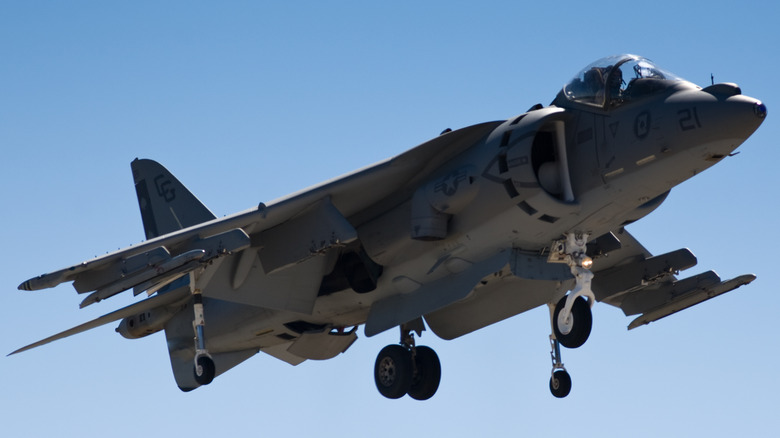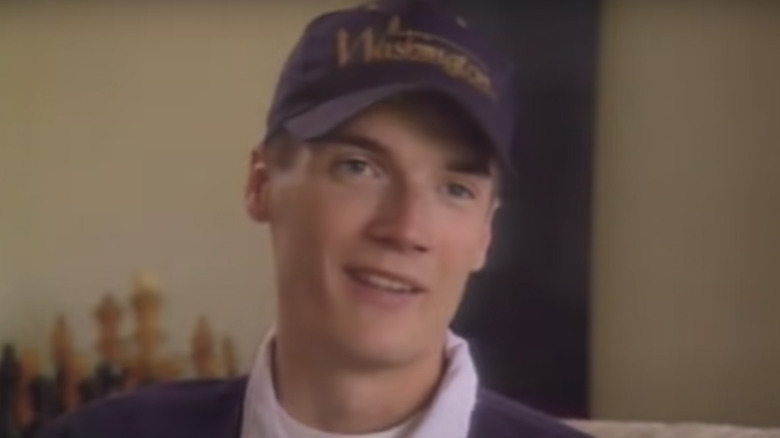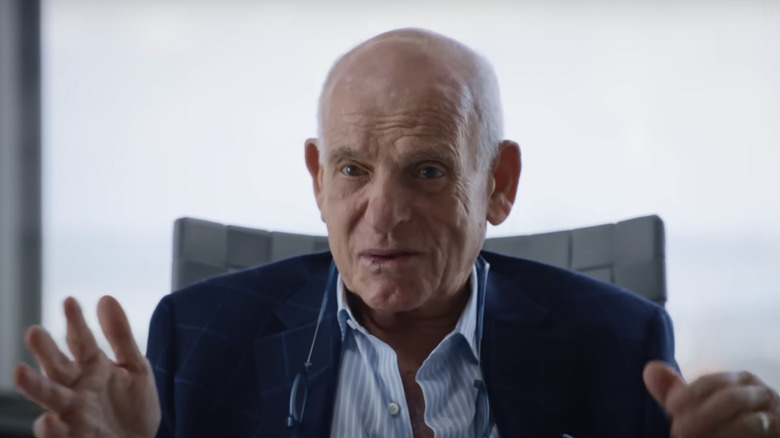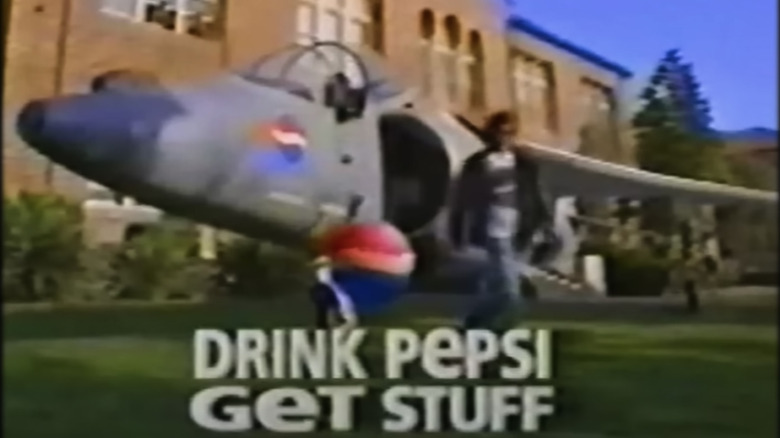Why A 21-Year-Old College Student Sued Pepsi For A Military Harrier Jet
Since the beginning of the 20th century, Coca-Cola and Pepsi have been engaged in a longstanding, intense competition for cola market dominance. Sure, over the years some other drinks like RC Cola, Jolt, and Tab (RIP) have tried to throw their hat in the cola ring, but everybody knows it's a two-way rivalry between the two sugary, syrupy, dark, carbonated giants. Per History, by the late 1970s, with neither Coca-Cola nor Pepsi showing any sign of ceding ground to the other, the competition ratcheted up to what became known as the cola wars, complete with advertising campaigns that directly took shots at the competition. By the 1990s, Pepsi was spending tens — if not hundreds — of millions of dollars on campaigns centered around A-List celebrities such as Michael Jackson, Britney Spears, Ray Charles, and the Spice Girls, according to The New York Times.
At the same time their advertising campaigns were reaching new audiences, Pepsi looked to create a rewards program that would turn customers into walking promotions. Per another New York Times report, executives at Pepsi wondered if they could borrow promotional techniques from Philip Morris, with its "Marlboro Gear" campaign. So, between 1995 and 1996, under the "Drink Pepsi, Get Stuff," campaign, Pepsi launched "Pepsi Stuff," which allowed customers to accumulate points with the purchase of Pepsi products to buy company-branded T-shirts, bags, hats, and even larger items, according to Wired. It was all going swimmingly — until a 21-year-old college student got a bright idea, that is.
Leonard wanted the Harrier jet
In 1996, John Leonard, a 21-year-old community college student from Lynwood, Washington, was watching television when he saw a commercial for the "Drink Pepsi, Get Stuff" campaign (via YouTube). The ad spot gave a rundown of some of the gear that customers could trade points for, but only one item caught his eye: a Harrier military jet was on offer for 7 million points. Or was it? As far as Leonard was concerned, he was getting the jet. He wasn't sure exactly how he was going to do it since he would have to consume 16.8 million cans of Pepsi to rack up those 7 million points, per The Hustle. Even with his self-admitted 10-can-a-day Pepsi habit, it was an impossible feat.
But as he flipped through the Pepsi Stuff catalog, he noticed the fine print. Per the rules, he could pay 10 cents for each point needed. According to the AP, Leonard also called the company to confirm that he could buy points at that rate. At that moment, he put the Pepsi can down and started working the phone to find investors who would put up the $700,000 to buy enough points to net the fighter jet. (Wired reports that at the time, the aircraft in question cost the U.S. Marine Corps around $20 million each.) Eventually, he gathered five friends he met on a hiking trip to fork over enough cash to get that certified check (plus a curious $10 for shipping and handling — of a massive military jet). So, that's that, right? Not so fast.
Pepsi responds
Within days of Leonard sending his $700,000 check, Pepsi sent a letter to him on May 7, 1996. It was not good news. The company told Leonard that the Harrier was not in the catalog, nor was it on the order form, and, therefore, it was not among the merchandise that can be redeemed in the Pepsi Stuff program. Further, the company explained their use of the jet. "The Harrier jet in the Pepsi commercial is fanciful and is simply included to create a humorous and entertaining ad," the letter read (via The Hustle). "We apologize for any misunderstanding or confusion that you may have experienced and are enclosing some free product coupons for your use."
According to the AP, Leonard tried two more times to submit the check and request for the Harrier jet, but was turned down each time. That's when Leonard got a lawyer, Larry Schantz (above), and wrote to Pepsi: "Your letter of May 7, 1996 is totally unacceptable. We have reviewed the video tape of the Pepsi Stuff commercial ... and it clearly offers the new Harrier jet for 7 million Pepsi Points." He added: "If we do not receive transfer instructions within ten (10) business days of the date of this letter you will leave us no choice but to file an appropriate action against Pepsi." And this is where it gets messy.
A Pepsi public spectacle
As promised, John Leonard's lawyer, Larry Schantz, filed suit in the Southern District of New York against PepsiCo in August 1996, accusing the company of breach of contract, fraud, deceptive and unfair trade practices, and misleading advertising, according to court filings (via Justia). Then, the ordeal started to play out in public. "The (commercial) itself and the Harrier at the end is clearly a spoof, and I think everyone knows that, but I think Mr. Leonard is clearly getting carried away," Pepsi spokesman Brad Shaw told the Tampa Bay Times in 1996. For his part, Leonard stuck to his guns. "I didn't want any publicity on this," he said (via the Seattle Times). "They brought the public light on this. My sole intention was to get the plane. I'm not trying to make a statement. I'm not looking for a settlement. I just want a plane."
Ultimately, after three years tied up in court, Leonard did not get his Harrier jet. The judge rejected his claim on three fronts: Advertisements are not generally considered an offer, the ad was seen as a joke by any reasonable person, and enforceable contracts require both parties' signatures, per Mental Floss. Leonard and his lawyer appealed the decision in 2000, but got no closer to the Harrier. For its part, Pepsi kept running the ads, but made the point value on the jet go from 7 million to 700 million points and tacked on "just kidding" to the end of the commercial.
The "Pepsi, Where's My Jet?" docuseries streams November 17 on Netflix. The trailer is on YouTube.



